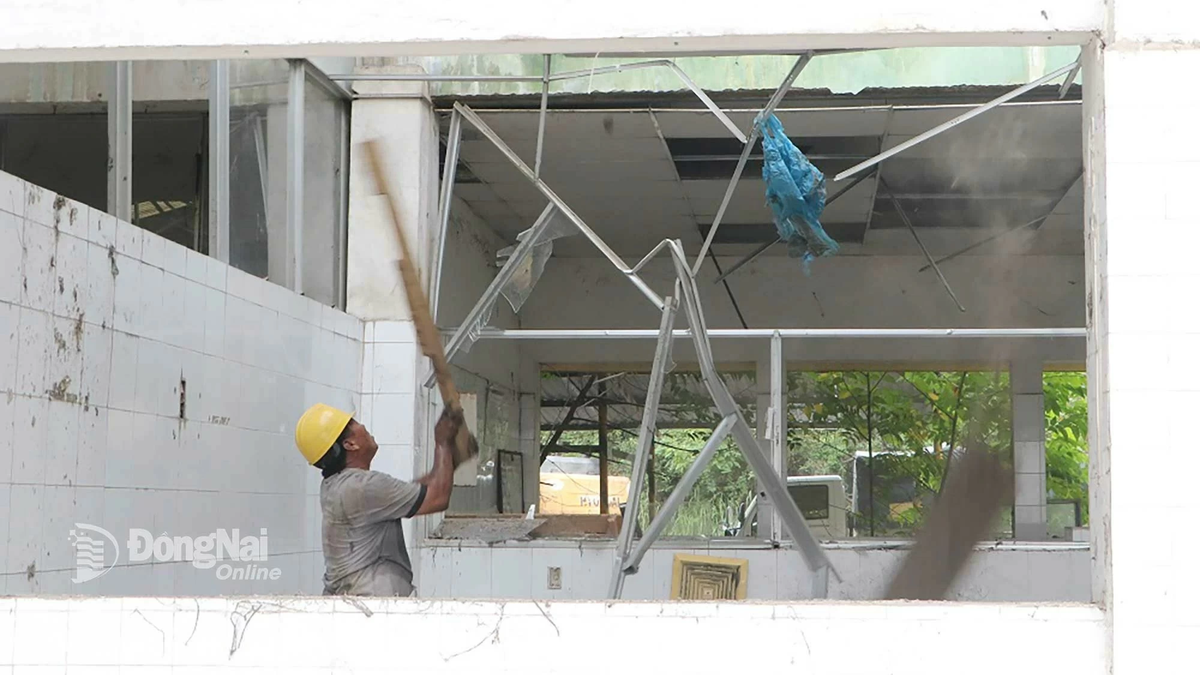At the foot of Giang Man mountain, Minh Hoa district, people have changed from domesticating wild bees to raising honey, which has now become a high-income profession.

In the beekeeping garden of Mr. Dinh Long, dividing the beehive and collecting honey. Photo: T. Duc.
Unique profession of "bee eating"
It is no exaggeration to say that Mr. Dinh Long (Xuan Hoa commune, Minh Hoa district, Quang Binh province) is a famous person among many people who work in the "bee-eating" profession (the name given by the people of the mountainous region of Quang Binh to people who specialize in going into the forest to collect honey or catch wild bees to domesticate).
From his youth until now, at the age of “ancient and rare”, he still loves this profession. When Minh Hoa district decided to establish the Beekeeping Association, he was elected as the Association’s President and there were even people who raised both hands in support.
“The bee-hunting profession is still practiced today, but not often. Partly because many home-raised bee colonies separate from their colonies, and partly because wild bees have to travel farther,” he confided to us.
Mr. Dinh Long also remembers that when he was a teenager, his father took him into the forest to teach him how to observe worker bees eating nectar on the mountainside or when they swoop down to drink water from a dry stream. His father taught him to observe how many spirals they made in flight to know which direction the beehive was facing and how far away it was.
“Back then, we only focused on collecting honey. There were very few bees that were caught, domesticated and raised. In the village, only a few houses hung two beehives at the two ends of the house, but not many kept them. People were afraid that the bees would sting children, which would be dangerous,” Mr. Long said, nodding.
When his father taught him the trade, Mr. Long realized the beauty of the "beekeeping" profession. This is not just a way to earn money, but also to experience the discipline and hard work of bees and to immerse himself in nature with many interesting things.
According to Mr. Dinh Long, every year when the cool winds blow, the weather changes from cool to cold, it is also the time when honey bee colonies living naturally in the deep forest begin the process of migrating to find a place to hibernate and avoid the cold.
“Normally, the place where wild bees nest and hibernate is usually tree hollows or later hollow electric poles of power lines to the border area. That is also the time when “bee hunters” use their skills to lure bees into the bait hives they bring with them,” said Mr. Long.
Accordingly, the bait nest is a piece of wood, usually jackfruit wood, drilled and hollowed out in the middle, with both ends sealed. On the body of the bait nest, in the middle, there is a small hole called the door. Before hunting for bees, the worker uses pure honey to smear a little on the top of the nest to create a scent that attracts wild bees.
When the cold winter is approaching, bees often choose large hollow trees or hollow electric poles to build their nests to shelter from the winter wind. If they are from Quy Dat town (the center of Minh Hoa district), the bee hunters follow National Highway 12A towards Cha Lo International Border Gate to make their hunting trip.
Along the way, we will inevitably meet many groups of hunters from Hoa Hop, Hoa Tien, Hoa Thanh communes and even people from Ha Tinh coming in the opposite direction. The tools they bring are also simple, which are a net made of mosquito net and a few bait nests that the locals call “hang”. They go, meet, chat, become close friends and become good friends, ready to help each other in their profession or chat about good things and stories from their hometown.

Mr. Dinh Long is checking the quality of the beehive. Photo: T. Phung.
Interesting profession of luring "bees" and "bee san"
Mr. Dinh Long told us that in the past, wild bees often chose hollow tree trunks to build their nests, but recently hollow electric poles have been more often chosen by bee colonies to make their nests to stay in during the winter.
When winter comes, the job of choosing a hive to shelter the bees from the cold is assigned to the fastest and healthiest worker bees in the hive. These bees are called "porcelain bees" by the beekeepers, and in some places called "visiting bees". The bees assigned this task fly around everywhere and often look for pre-cast holes on electric poles or natural holes on tree trunks to find shelter for the hive.
When detecting "porcelain" bees, the worker quickly chases them away and when conditions are favorable, uses a net to catch them. After that, skillfully puts the "porcelain" bees into the bait nest, seals them tightly for a few minutes, then opens the door to release them. "For the "porcelain" bees, when released into the nest, they still have the task of exploring and finding out if it is an ideal place to build a nest. If they see it, they fly away and call the swarm back," Mr. Dinh Long shared his experience in luring bees.
“When the “angel” flew away, the “bee hunters” began to anxiously wait for the results. Because we know right away whether this stage is successful or not,” Mr. Dinh Long continued the story.

Many families in Minh Hoa district have developed bee colonies into their main source of income. Photo: T. Phung.
According to Mr. Long, from the time the "porcelain" bee is captured and brought into the bait nest until the end of the process of successive waves of bees arriving is called the "bee visit" process. Because when the "porcelain" bee leaves the bait nest and flies away, there are two possibilities. "One is that it leaves to find another place, two is that it returns to call the swarm. If you wait about ten minutes and do not see the "porcelain" bee return, the "bee eater" knows that it has failed and must find another one to repeat the process, with the hope that the swarm will return," Mr. Dinh Long added.
In addition to catching the “porcelain” bees and putting them in the bait nest to call the swarm back, the “bee hunters” also look for electric poles where bees have nests to hunt. On these electric poles, the bees have already built nests, meaning that they have settled there and the possibility of them leaving the nest to go to the bait nests is very unlikely. Therefore, the workers have to use torches or incense sticks to smoke them. The bees cannot stand the smell of incense smoke and will break the nest and fly out.
Before that, the worker had hung many bait nests around that area. When the bees broke out of the nest, they flew out and found the bait nests that were already hung and flew in to take shelter. When all the bees were inside the nest, the worker just needed to gently cover the hole with leaves or paper and bring the bait nest and the bees inside home, starting another process called “honeycombing”.

From wild bees to domestic bees, they have become a lever to help many households escape poverty. Photo: T. Phung.
Mr. Dinh Long said: “From the small, compact beehive, the bees will be transferred to other, larger hives. From here, the bees begin the process of growing and working so that about three months later, through spring, when the air is warm and hundreds of flowers bloom, the bees will produce honeycombs full of honey.”
According to many experienced bee hunters, the bee hunting season takes place during the last three months of the year. During that time, many people collect dozens of hives, but others only collect a few.
In Bai Dinh village (Dan Hoa mountainous commune, Minh Hoa district), I made an appointment with Mr. Le Van Bon (from Huong Khe district, Ha Tinh province) to come here to hunt for bees. Mr. Bon said that it was not because there were no more bees out there, but he also wanted to come here as a way to travel to all the countryside, to learn more about the customs and practices of other countries.
“I started last year’s bee season. That year, the whole long trip yielded nearly fifty beehives. This year, I haven’t had much luck, so I’ve only gotten a little over twenty. Next year, I’ll probably go to Con Cuong. There’s joy everywhere. Normally, a breeding colony costs 500,000 VND, but a large colony and when the price goes up, it can sell for a million VND,” Mr. Bon confided about his profession.
(To be continued)
Huong Hoai (According to nongnghiep.vn)
Source























































![[Maritime News] Container shipping faces overcapacity that will last until 2028](https://vphoto.vietnam.vn/thumb/402x226/vietnam/resource/IMAGE/2025/7/30/6d35cbc6b0f643fd97f8aa2e9bc87aea)













































Comment (0)